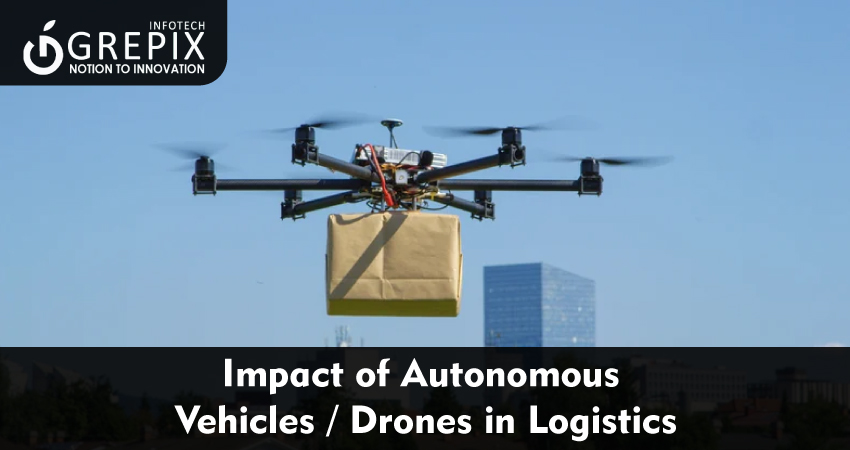Impact of Autonomous Vehicles / Drones in Logistics
In 2025, the logistics industry finds itself at the precipice of a technology revolution driven by autonomous vehicles logistics, drones in delivery, and the rise of sophisticated logistics apps. Demand for faster, more reliable, and greener deliveries has never been greater, with e-commerce, essential goods, and retail chains seeking new models to overcome labor shortages, rising costs, and consumer expectations. Autonomous vehicles and drones are leading the transformation, bringing driverless delivery technology to the forefront of modern supply chains.
The rapid advancement of autonomous vehicles logistics and drones in delivery is revolutionizing how goods are moved, stored, and managed worldwide. These driverless delivery technologies are shaping the future of logistics apps, introducing unprecedented speed, accuracy, and efficiency to global supply chains. From real-time route optimization to contactless deliveries, autonomous vehicles and drones are tackling labor shortages, reducing operating costs, and enhancing last-mile coverage. Major retail and tech players are piloting AV and drone solutions, with case studies from the US, China, Europe, and Africa highlighting real-world impact. While the industry recognizes numerous benefits such as sustainability, scalability, and improved customer experience, challenges remain in the form of regulatory hurdles, safety concerns, and technology integration. This article explores emerging trends, real-life implementations, benefits, obstacles, and future growth in autonomous vehicles logistics and drones in delivery, with actionable insights for businesses seeking to stay ahead in the rapidly evolving logistics landscape.
Emerging Technologies: Autonomous Vehicles Logistics
Next-Gen Logistics is Autonomous
Autonomous vehicles logistics has transitioned from theoretical prototypes to commercial reality, with numerous companies launching autonomous trucks, vans, and robots for real-world applications. These solutions leverage advanced sensor systems, AI-powered navigation, and real-time fleet management to deliver goods efficiently, safely, and at any hour.
Key Statistics:
- The global autonomous vehicles market is projected to reach $624 billion between 2025 and 2029, with a CAGR of nearly 40%.
- Autonomous freight & logistics market expected to grow from $53.45 billion (2024) to $185.14 billion by 2032.
- Logistics AI market increasing exponentially expected to hit $26.35 billion in 2025.
Technology Drivers
- AI & Machine Learning Integration: Predict demand, optimize routes, and reduce inefficiencies using data-driven algorithms in logistics apps.
- Connected IoT Ecosystem: Real-time vehicle-tracking, predictive maintenance, and automated reporting through connected sensors.
- Cloud-based Logistics Apps: End-to-end visibility, automated dispatching, and scalable fleet orchestration for driverless delivery technology.
Role of Autonomous Vehicles in Logistics
Autonomous Trucking
Self-driving trucks are revolutionizing long-haul deliveries, enabling fleets to operate around the clock and bypass traditional human limitations. By integrating LIDAR, radar, and AI-driven route selection, they offer:
- Reduced transit times.
- Lower fuel consumption via optimized driving patterns.
- Solution to persistent driver shortages.
Companies such as Waymo, TuSimple, and Embark are actively piloting autonomous trucks on US highways, with promising results.
Industry Insights
- 42% of logistics professionals anticipate widespread use of self-driving trucks on public roads within 15 years.
- 17% of surveyed experts rank autonomous trucks and drones as the most disruptive technology in logistics through 2025.
Autonomous Last-Mile Robots
Besides trucks, smaller autonomous vehicles robots and pods are operating in urban environments, college campuses, and business districts. These vehicles optimize short distance delivery, handle regular routes, and offer scalable “delivery as a service” options.
Real-Life Example
Walmart and Amazon have launched autonomous robo-van pilots for last-mile deliveries in select US markets, cutting delivery time by up to 30%.
Role of Drones in Delivery
Drone Delivery Ecosystem
Drones in delivery have become the poster-child for futuristic logistics, especially for last-mile coverage and rapid-access scenarios. Drone technology brings contactless, high-speed, and sustainable delivery solutions to urban and remote locations alike.
Market Growth
- Analysts predict operating costs for drone delivery services to be 40-70% lower than vehicle-based delivery.
- Global drone delivery market projected at $8 billion by 2027, with a CAGR of 41.8%.
Adoption & Case Studies
Healthcare & Remote Medical Supply
- Rwanda and Ghana employ medical drones for delivering supplies to isolated communities, saving lives through rapid response.
- In the US, Flirtey and 7-Eleven made 77 drone deliveries in Nevada, marking the first FAA-approved, store-to-home drone operations.
E-commerce & Retail
- Amazon, UPS, DHL, and Walmart are actively piloting drone delivery services, with Alphabet’s Project Wing testing food deliveries on university campuses.
- China and Japan have successfully integrated parcel drones for city-wide deliveries in high-density urban centers.
Drone Delivery Operations
- Drone Service Providers.
- National Aviation Authorities for airspace control.
- Pilots and ground support for launching, loading, and managing flights.
- Advanced logistics app integration for optimized scheduling, tracking, and compliance.
Benefits of Autonomous Vehicles Logistics & Drones in Delivery
Key Advantages
- Efficiency & Speed: AVs and drones drastically cut delivery times, operate 24/7, and expedite fulfillment for businesses and consumers.
- Cost Reduction: Lower dependency on drivers reduces labor costs; drones in delivery have up to 70% lower costs compared to traditional methods.
- Sustainability: Electric-powered AVs and eco-friendly drones decrease carbon footprint, supporting greener operations.
- Scalability: Driverless delivery technology enables rapid scaling through software and hardware, without compliance on manpower.
- Safety & Contactless Delivery: Minimizes risks during pandemics; ensures safe, traceable transactions.
- Data-Driven Optimization: Advanced logistics apps enhance real-time tracking, route optimization, and performance analytics for better resource allocation.
Real-World Case Studies
- Zipline has delivered over 200,000 medical packages across Africa via drones, with near-perfect delivery accuracy.
- Domino’s DomiCopter in New Zealand integrates drones for food delivery, with successful tests demonstrating practicality.
Challenges in Driverless Delivery Technology
Regulatory & Safety Hurdles
- Legal Frameworks: National and local governments struggle to keep up with rapid autonomous vehicle deployment, resulting in patchwork regulations.
- Airspace & Route Integration: Drone traffic management needs sophisticated systems to avoid congestion and ensure safety.
- Cybersecurity Risks:Connected logistics apps and vehicles are vulnerable to hacking and data breaches.
Technical & Operational Concerns
- Weather Dependence: Drones in delivery are susceptible to weather delays and environmental hazards.
- Urban Navigation: AVs face challenges in congested areas, requiring continuous sensor and AI upgrades.
- Public Acceptance: Consumer trust hurdles persist; concerns around privacy, reliability, and the broader societal impact.
Market Adoption
Despite pilots and promising results, no company has reached large-scale commercialization of driverless delivery technology. Most are still refining operational models and regulatory compliance.
Future Outlook for Logistics Apps and Delivery Technology
Trends Shaping the Decade
- AI-Driven Route Optimization: Logistics apps will leverage AI for hyper-efficient scheduling, live rerouting, and adaptive delivery in unpredictable conditions.
- Autonomous Vehicles Logistics Expansion: Widespread adoption is expected, with AV fleets growing across North America, Europe, and Asia by 2030.
- Mass Drone Adoption: Gartner forecasts 1 million drones carrying out retail deliveries by 2026, up from just 20,000 today.
- Green Supply Chain Initiatives: Companies will use electric fleets and drones, integrating sustainability goals into core logistics strategies.
- Custom Logistics Apps: Cloud-based, scalable, and deeply integrated apps will become the backbone for driverless delivery technology, supporting rapid onboarding and agile operations.
Opportunities for Businesses
- Embracing autonomous vehicles logistics and drones in delivery means:
- Faster fulfillment rates and improved customer loyalty.
- Scalable, future-proof supply chains ready for global growth.
- Reduced operational costs and environmental impact.
Conclusion
Autonomous vehicles logistics and drones in delivery have emerged as the transformative forces leading the future of logistics apps. By integrating AI, real-time tracking, and advanced driverless delivery technology, businesses are seeing dramatic improvements in speed, transparency, and scalability. From long-haul trucking without human intervention to last-mile drone deliveries in urban and remote areas, the evolution is tangible, with major players piloting solutions worldwide.
While challenges such as regulation, technical limitations, and cyber-security persist, the overall trajectory points towards accelerated adoption and market maturity in the coming decade. Companies willing to invest in custom logistics apps and autonomous solutions will be best positioned to capitalize on emerging trends, improve customer experience, and stay ahead of the competition.
FAQs
1. How do autonomous vehicles logistics improve supply chain efficiency?
Autonomous vehicles logistics optimize route planning, reduce transit time, and lower costs by enabling 24/7 operations with minimal human intervention.
2. Are drones in delivery safe and regulated?
Drones in delivery are subject to aviation regulations, with national aviation authorities managing airspace and operational standards; safety improves as technology matures and robust systems are deployed.
3. What are the main benefits of driverless delivery technology?
Key benefits include reduced labor costs, faster deliveries, higher accuracy, improved sustainability, and enhanced customer experience through contactless service.
4. Will logistics apps continue to evolve with these technologies?
Yes, logistics apps will become more intelligent and customizable, supporting deeper AI integration for predictive analytics, personalized delivery, and efficient fleet management through 2025 and beyond.
5. Can small businesses access autonomous vehicles logistics and drones in delivery?
While large corporations lead adoption, emerging “as-a-service” models and affordable logistics apps are enabling small businesses to reap benefits, joining pilots and regional programs.







